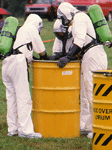Hazardous Materials

Environmental health practitioners help ensure that the proper controls are in place and are maintained to prevent chemical releases. When releases do occur, practitioners respond to limit human exposure and minimize the impact on the environment.
Because of terrorism concerns, practitioners must be prepared to respond not only to unintentional releases but to intentional releases as well.
This section provides key information on preventing and preparing for chemical releases.
Agency for Toxic Substances and Disease Registry (ATSDR) Resources on Chemicals and Hazardous Materials – agency responsible for assessing the health of people living near hazardous waste sites
- Medical Management Guidelines – guidelines for healthcare professionals involved in acute exposures resulting from chemical incidents
- ToxFAQs – answers to the most frequently asked questions (FAQs) about exposure to hazardous substances
- Toxicological Profiles – detailed information about 275 hazardous substances
CDC Chemical Agents List – list of chemicals and toxicants of concern
CDC National Institute for Occupational Safety and Health (NIOSH) Emergency Response Resources – emergency response topics
- Chemical Hazards Information – information for first responders about chemical agents
- Disaster Site Management – recommendations for supervisors and responders
- Emergency Responders – information about the different types of first responders
- Natural Disasters – recommendations for responders to natural disasters
- NIOSH Pocket Guide to Chemical Hazards – booklet containing information on industrial hygiene for workers, employers, and occupational health professionals
- Personal Protective Equipment – recommendations on personal protective equipment for first responders
- Terrorism Response – information for first responders about terrorism
Links to information from outside CDC
Environmental Practice and Response Fundamentals (University of Minnesota, Center for Public Health Preparedness) – online training to build skills needed by environmental health professionals to operate in different emergency situations
Environmental Protection Agency (EPA) – information about preparing for and responding to chemical releases
- Chemicals in Your Community – pamphlet of information you can use to build a snapshot of chemicals stored and released in your community
- Emergency Planning and Community Right to Know Act (EPCRA) Information
- Emergency Response – links to the National Response System (NRS) of federal, state, and local officials
- EPA Envirofacts Data Warehouse – tool to search for environmental information pertaining to specific areas
- EPA Enviromapper – tool that maps various types of environmental information
- EPA Environmental Response Team (ERT) – provides assistance for oil and hazardous material spills
- Extremely Hazardous Substances (EHS) Chemical Profiles and Emergency First Aid Guides – guide that provides signs and symptoms of chemical exposure and what emergency treatment to perform
- Preventing Chemical Accidents – links to safety alerts, investigational reports, and chemical safety audits
- Toxic Release Inventory Explorer – tool to generate reports about toxic releases in specific areas
- Vulnerable Zone Indicator System – tool to find whether an address (home, place of work, school) could be affected by a chemical release
Federal Emergency Management Agency (FEMA):
- Preparedness – guidelines on emergency planning and management of hazards, especially useful to the environmental health professional.
- State and Local Guide 101: Guide for All-Hazard Emergency Operations Planning [PDF – 603 KB]
- Chapter 6, Attachment C: Hazardous Materials [PDF – 13 KB] – emergency operations planning for hazardous waste
HazMat Transportation Incidents: Using the Emergency Response Guidebook (University at Albany, State University of New York, Center for Public Health Preparedness) – ERG training increases public health workers awareness of hazardous materials being used in or transported through their communities
National Library of Medicine – information about disaster and emergency preparedness and response grouped in related categories:
Oak Ridge National Laboratory Emergency Management Program (EMP) – conducts applied research and assists in the development of emergency planning capabilities
- Risk Communication and the Chemical Stockpile Emergency Preparedness Program – links to research reports and training material
The Twin Cities Metro Advanced Practice Center – tools and resources for preparedness that can be used by public health departments nationwide, including
- Environmental Health Emergency Response Guide, Chapter 8: Hazardous Waste [PDF – 658 KB] – provides quick access to needed information before an incident strikes a community
U.S. National Response Team (NRT) – interagency organization responsible for coordinating emergency preparedness and response to oil and hazardous substance pollution incidents:
- Developing a Hazardous Materials Exercise Program – Handbook that provides state and local governments with practical advice to develop a hazardous materials exercise program
- Hazardous Materials Planning Guide 2001 Update [PDF – 1.15 MB] – guide to help local communities develop a hazardous materials community response plan
- Incident Command System/Unified Command Technical Assistance Document [PDF – 472 KB] – guide for the Incident Command System
Suggested Resources:
Emergency Response Guidebook – Provides responders with information to quickly identify the specific or generic classification of the hazardous material and how to protect themselves and the general public during the initial response phase.
American Conference of Governmental Industrial Hygienist 2003 TLVs® and BEI’s® – guide to evaluate and control workplace exposures to chemical substances and physical agents
Field Management of Chemical Casualties Handbook, 2nd Ed. [PDF – 427 KB] (U.S. Army Medical Research Institute of Chemical Defense [USAMRICD])
Medical Management of Biological Casualties Handbook, 7th Ed. [PDF – 2.5 MB] (U.S. Army Medical Research Institute of Infectious Diseases [USAMRIID])
Medical Management of Chemical Casualties Handbook, 4th Ed. [PDF – 1.02 MB] (U.S. Army Medical Research Institute of Infectious Diseases [USAMRIID])
World Health Organization (WHO):
- Page last reviewed: October 1, 2009
- Page last updated: June 22, 2017
- Content source:


 ShareCompartir
ShareCompartir